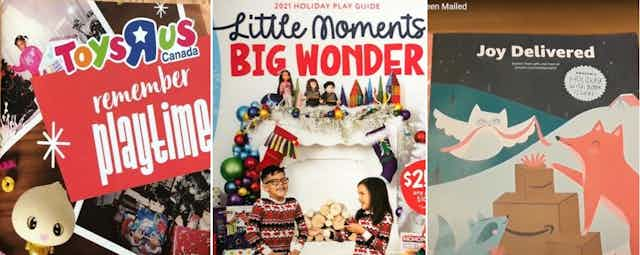Did you receive them? Found in many mailboxes in this second pandemic holiday season were paper catalogues from Toys “R” Us, Mastermind Toys and perhaps most surprisingly, the highly profitable digital retailer Amazon. Amazon first launched a toy catalogue in 2018 and mailed it to millions of customers.
While it might seem that paper catalogues would be relegated to history with the advent of e-commerce, it seems as if, at least for these retailers, they are still part of doing business.
To understand why catalogues formed part of these retailers’ promotional strategy, let’s explore some retail history.
Connection to the past
Almost 140 years ago, department store retailer Eaton’s produced its first mail-order catalogue, with Simpson’s following suit 10 years later.
These catalogues are so important to the history of Canada that you can see them in the collections of the Library and Archives Canada and the Canadian Museum of history. Some Christmas catalogues grew to hundreds of pages.

Nostalgia and childhood
The way we celebrate holidays is based in part on what we learned from our families as children. Consumer studies researchers have examined how holidays ideally involve the creation of special foods that take time and effort, the coming together of special people in our lives and making memories that we recall with pleasure long afterwards.
Thinking positively about people, events or places that happened in the past is called nostalgia. We can even feel nostalgia for something that occurred before we were born through seeing objects from the past, or hearing the memories of others.
Some contemporary consumers or their grandparents in Canada today had the experience of receiving or reading the Eaton’s and Sears Christmas catalogues as children. Sears even called their Christmas catalogue the “wish book.”
Amazon, once focused on promoting products with a digital wish list, promoted its 2020 catalogue as a “Holiday Wish Book” and this year describes it as a holiday kids book.
Read more: How the holiday buying season adds fuel to a rapidly warming planet
While it is possible to remember without physical artifacts, the three dimensional and tactile information received from interacting with paper documents help to reinforce people’s memories and knowledge retrieval. People may have had the experience of going carefully through each catalogue page, marking it up and folding down the pages — whether or not they received what they wanted.

As Archives Ontario notes, not only did the Eaton’s catalogue make an emotional impression, it even made its way into some Canadian literature. For example, in The Hockey Sweater, by Québec writer Roch Carrier, a devastating mail-order mixup means a most unwanted Toronto Maple Leafs sweater from Eaton’s arrives at his childhood home.
Emotion aside, how do catalogues influence sales?
While nostalgia can be a powerful motivator for consumers who consider shopping today at physical toy stores or online retailers, companies must consider catalogues’ effects on sales and return on the investment.

Toys “R” Us and Mastermind Toys (both physical stores) and Amazon have a short corporate histories compared to Eaton’s and Simpson’s (later Simpsons-Sears), and none had mail-order businesses. Mastermind Toys and Amazon grew up during the advent of e-commerce, so using this seemingly old-fashioned technology seems curious.
But let’s consider that while social media seems to attract consumers’ attention and quickly, digital clutter is a common consumer complaint.
Home-delivered paper catalogues can be part of leisure reading and are artifacts with esthetic, symbolic and instrumental value. Catalogues present images and text that are viewed as the retailer intended, without the mediation imposed by the consumer’s screen size and device capabilities.
Paper catalogues create a richer sensory experience compared to a digital catalogue or online store. Touch creates a sense of ownership and so consumers may be more likely to purchase.
Read more: Consumers value a product viewed online more if they see it being virtually touched
For toy companies, the October to December period represents almost 50 per cent of their yearly sales. The critical job for toy retailers is to get the attention of consumers for their store. As Canada Post argues in a 2015 report promoting direct mail, research suggests direct mail paper catalogues can serve as an effective trigger for visiting an online store, and their physical presence in the home and in leisure spaces can act as an ongoing prompt or reminder to visit.
Connect in new way?
So in addition to selling toys, why is Amazon sending out paper catalogues? Amazon is likely concerned about its brand. The company has faced widespread condemnation of its labour practices. It has responded with commercials featuring happy employees with varied abilities and gender identities.
In the face of criticism of its impact on small and medium retailers, Amazon set up its Shop Local Campaign to promote products from small and medium Canadian companies. I believe sending paper catalogues helps them tap into the long tradition of Christmas catalogues and connect in an emotional and surprising way with their customers.

